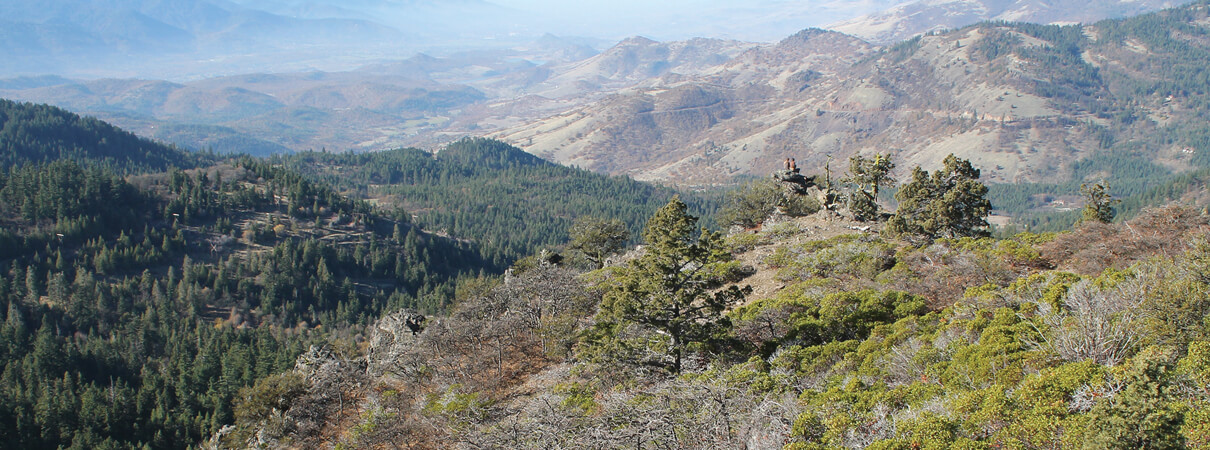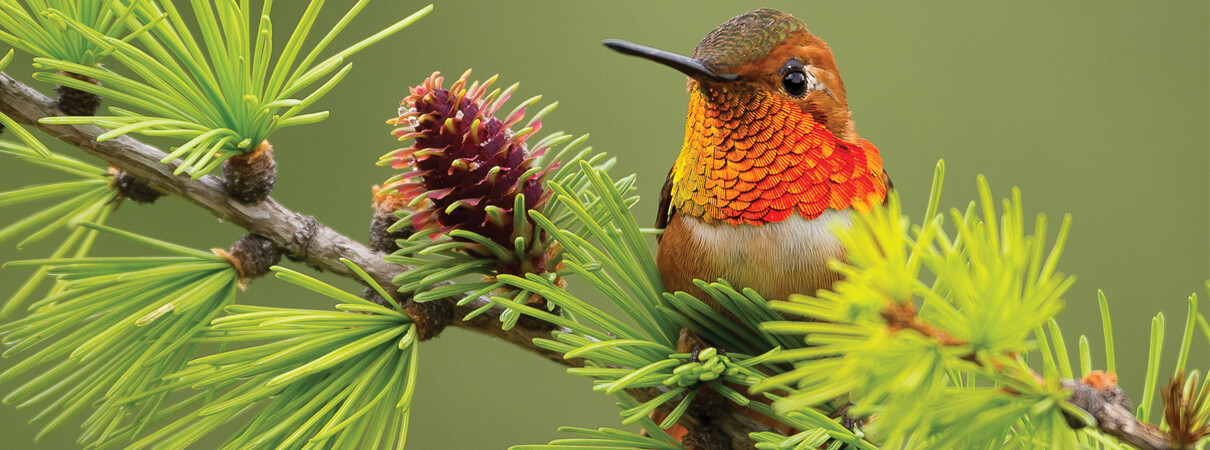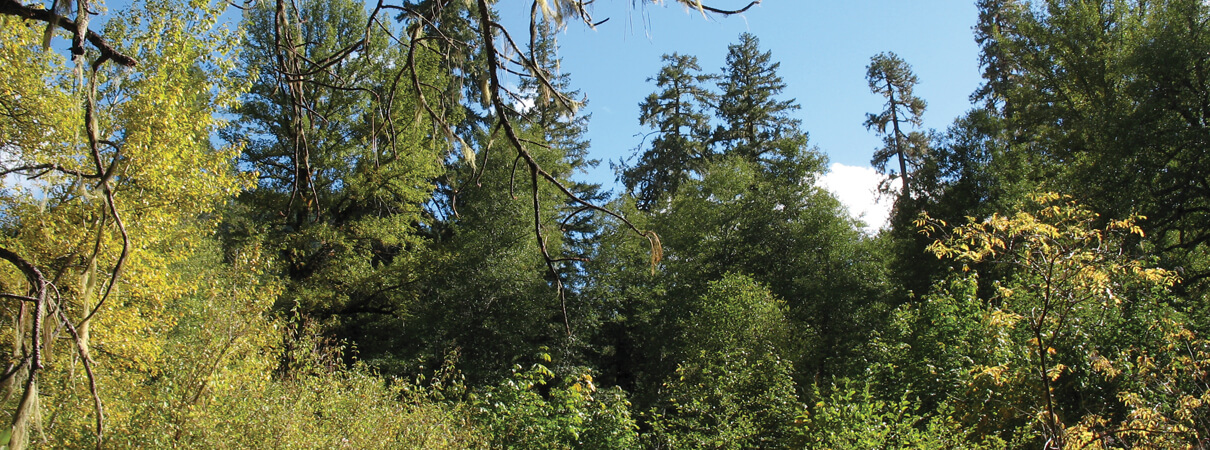New Project in Oregon's Klamath Mountains Aims to Enhance Working Forests for Birds
What can a hummingbird reveal about the health of a forest?
That's a key question conservationists and forest products companies will be trying to answer later this year on private forest lands in southwestern Oregon. There, in the rugged forests of the Klamath Mountains, American Bird Conservancy will collaborate with the Sustainable Forestry Initiative (SFI), Klamath Bird Observatory, and the National Council on Air and Stream Improvement. The partners are undertaking a two-year project to assess and enhance forest management for more than 15 bird species of special concern—including the Rufous Hummingbird.

Rufous Hummingbird stands to benefit from a new forest management partnership. Photo by Edward Lai
Across the United States and Canada, more than 280 million acres of forested land are certified to the SFI Forest Management Standard. Millions more are positively impacted through the SFI Fiber Sourcing Standard. Over the past 20 years, SFI has had a positive influence on responsible forest management, from Canada's boreal to the U.S. Southeast.
The next step: understanding the value of those forests as bird habitats and using that vast expanse of working forests to increase conservation for birds and other wildlife.
Good for Birds? Good for Other Critters, Too
That's exactly the goal in the Klamath Mountains. Given how many acres forest products companies influence there, they can contribute to turning the trends around for Rufous Hummingbird and other birds that depend on various types of forest habitat to survive. By managing with an eye toward biodiversity, these companies create conditions that many birds need for successful breeding, migration, and wintering.
The hummingbird and other focal bird species, in turn, play a crucial role in helping forest products companies manage their acreage sustainably. Scientists have found that certain bird species' requirements for healthy habitat reflect what many other animals need, too.
If it's good for the birds, it's good for many other critters—and a sign of a thriving, well-balanced forest ecosystem.

Oregon's Rogue Valley. Photo by Brandon Breen, Klamath Bird Observatory
Forestry and forest economics will still guide the management, but the partners will use their knowledge of birds and habitat to look for opportunities to adjust their practices to enhance the conditions for a suite of species. The birds, in other words, will help to guide the management, says John Alexander, Executive Director of the Klamath Bird Observatory.
“We don't want to see birds get listed as endangered,” Alexander says. “We want to use our deep understanding of what birds represent to do better.”
A Common Hummingbird in Decline
Rufous Hummingbirds follow the nectar. Their tremendous migration—the longest of any hummingbird, up to 3,900 miles from Mexico to southeastern Alaska—is timed to coincide with the flowering of plants along the way.
The bird travels an elliptical route, heading up the lowlands of the West Coast in spring where plants flower early, then hitting the Rocky Mountains' high-elevation meadows on the return trip in the fall. The Klamath Mountains, which extend into northern California, mark the southernmost end of its breeding range.
The hummingbird is relatively common and widespread. But its population has declined across its range by 2 percent every year between 1968 and 2013, according to the North American Breeding Bird Survey. In the Klamath Mountains of southwestern Oregon and northwestern California, the annual declines are more than 3 percent.

Rufous Hummingbirds are in decline. Habitat loss and climate change are suspected causes. Photo by Scott Bechtel
Scientists don't know the precise reason for this decline. But they speculate that it seems to be the result of two trends: habitat loss, especially the conversion of forest habitat to pastureland in Mexico, and climate change, particularly recent droughts in the West, which reduce flowering of trees and shrubs. And so the hummingbird is much like the proverbial canary in the coal mine, says Bob Altman, ABC's Pacific Northwest Conservation Officer.
“When we see these declines, we want to dig a little deeper and say, ‘What's that indicative of?” Altman says. “Are we losing flowering plants due to insecticide spraying? Is the bird now out of sync with flowering because of climate change? Too much loss of habitat? If the bird is struggling, it raises a red flag about the conditions the bird represents.”
Klamath Mountains: "God's Country"
Some people who live in the Klamath Mountains call it God's country. Known as one of the most biodiverse temperate regions on the planet, the rugged region contains a remarkably rich array of trees and other plants.
The reason for this is that the Cascade Mountains, the Sierra Nevadas, and the ancient Klamath Mountains—and their three distinct forest ecosystems—all collide there. The abundance of tree and shrub species shelter a mix of birds that, like the Rufous Hummingbird, are also focal species in the new project. Species include Black-throated Gray Warbler, Pacific Wren, and Olive-sided Flycatcher.
But the health of these forest ecosystems is declining, and with it, many of the same bird species. Once, natural fires would disturb the forests and trigger natural cycles of new growth. Decades of fire suppression have prevented the forest from regenerating naturally. The lack of fire has deprived birds and other creatures from the different stages of forest habitat they need to thrive.
The forests' health depends on this disturbance. Now a new source of disturbance—in the form of forest management—will play that role. During the two-year project, Alexander says, scientists will work side by side with SFI program participants to assess what the companies are already doing on their commercially managed lands that benefits birds and where they can do more.
The central question is this: “How can we create habitat for birds within the economic and operational constraints of the companies?” Alexander says. “It's going to be about trying to find that sweet spot.”
Home to Hummingbirds
Rufous Hummingbird habitat tends to be young, shrubby forest with an abundance of trees and other vegetation that produce flowers and nectar. But in forests that are commercially managed for wood products, this kind of deciduous vegetation is sometimes compromised, as it competes with commercially planted conifer trees.

Rufous Hummingbird habitat in the Klamath Mountains. Photo by Sam Brown, Klamath Bird Observatory
There may be other ways in the context of commercial forest management to encourage conditions favorable to the hummingbird. Biologists know a great deal about the type of habitat Rufous Hummingbirds need. The project aims to better understand the habitats current sustainable forestry practices create and identify ways to make those habitats even better for birds.
There are several ways to provide good habitat for the hummingbirds:
- Maintaining small patches of flowering shrubs and other vegetation the hummingbirds love—salmonberry, columbine, currant;
- Allowing unmanaged young forest to regenerate naturally, along with keeping flowering shrubs in areas beneath transmission powerlines;
- Minimizing disturbance to the ground so it remains productive and healthy; and
- Allowing shrubs and young trees to grow in places where it's too difficult for pine, fir, spruce, or other conifer seedlings to survive, such as along logging roads, on steep slopes, or in depressions or gullies.
Birds are the focus of this project because they are a shared conservation priority for all of the forestry and bird conservation partners. They're also easy to monitor and serve as terrific barometers of a forest's health. But they're not the only creatures that benefit from the work, Altman says. Well-managed forests harbor the opportunity to provide a range of attributes that could benefit a multitude of species.
“If you are providing flowering trees and shrubs and the nectar they produce for Rufous Hummingbird, that also is a big potential benefit for any other pollinating animal—bats, too,” he says. And what's good for Rufous Hummingbird is also good for bees.
Yet although the hummingbird's presence in a forest signifies flowering trees and shrubs, “that's just one little part,” Altman says. “They don't represent big trees, they don't represent lush ground cover of grasses—all those other species represent all those other conditions out there. The forest is many things, and Rufous Hummingbird is just one of the pieces.”
Editor's note: This article first appeared in the summer 2016 edition of Bird Conservation magazine. Read more about ABC's work to improve forest habitat for birds in Appalachia and our ongoing partnership with the Sustainable Forestry Initiative to find "sweet spots" for bird conservation.
 Libby Sander is Senior Writer and Editor at American Bird Conservancy. Before coming to ABC in 2015, she spent 13 years as a journalist, writing news stories and award-winning features for The New York Times, the Washington Post, and The Chronicle of Higher Education. You can follow her on Twitter at @libsander.
Libby Sander is Senior Writer and Editor at American Bird Conservancy. Before coming to ABC in 2015, she spent 13 years as a journalist, writing news stories and award-winning features for The New York Times, the Washington Post, and The Chronicle of Higher Education. You can follow her on Twitter at @libsander.


















































